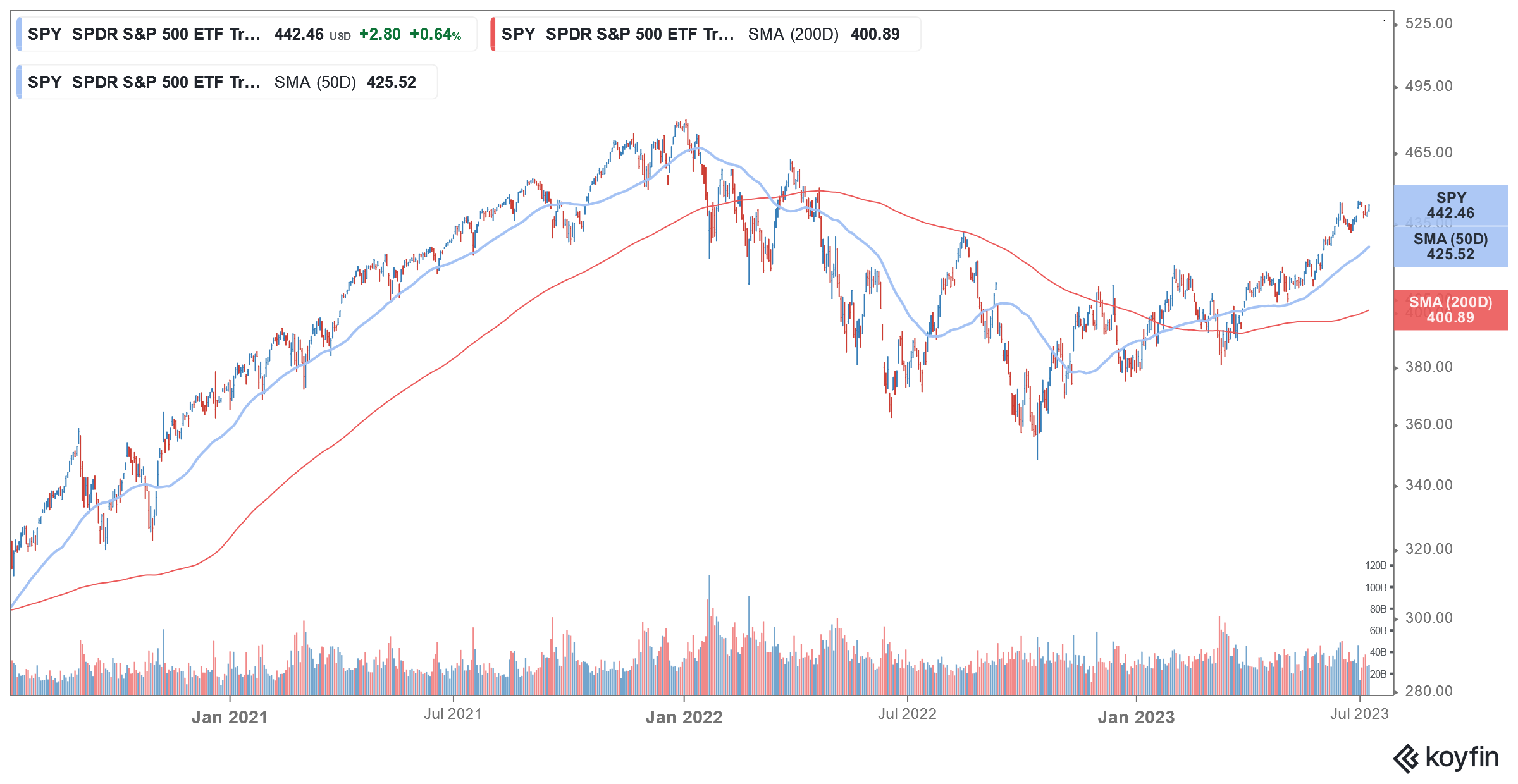Data released by the US Labor Department shows that US CPI rose at an annualized pace of 3% in June which was below the 3% inflation that economists were expecting and the slowest pace of rise since March 2021.
In its release, the Labor Department said, “The index for shelter was the largest contributor to the monthly all items increase, accounting for over 70 percent of the increase.”
Notably, the annualized CPI peaked at 9.1% in June 2022 which was the highest since the 1980s. A lot of younger Americans were not used to the kind of price rise that the world’s largest economy witnessed last year.
US inflation has fallen gradually
The US Fed also misread inflation and was late in raising rates as it believed the price rise was “transitory.” However, as things turned out higher prices were there to stay and the Fed had to embark on among its most hawkish rate hikes in decades.
The Fed embarked on its rate tightening cycle in March 2022 and raised its policy rates by 25 basis points – ending the zero-bound interest rates.
It graduated to a 50-basis point rate hike at the next meeting. Thereafter the US central bank raised rates by 75 basis points at four consecutive meetings before lowering the pace to 50 basis points in December.
This year, the Fed has raised rates thrice by 25 basis points lifting the interest rates to multi-year highs.
Fed paused its rate hikes in June
The Fed paused its rate hikes in June as it took a wait-and-watch approach after the banking crisis. The Fed meeting minutes released last week stated, “Some participants judged that it was still too early to assess with confidence the eventual effects of tighter bank credit conditions on economic activity and noted that it would be important to monitor closely the potential effects of banking-sector developments on credit conditions and economic activity.”
US inflation has also come down gradually and the June 2023 annualized CPI is less than a third of the June 2022 peak. Since that month however the annualized CPI has fallen in every month.
The minutes said, “Many [Fed officials] also noted that, after rapidly tightening the stance of monetary policy last year, the Committee had slowed the pace of tightening and that a further moderation in the pace of policy firming was appropriate in order to provide additional time to observe the effects of cumulative tightening and assess their implications for policy.”
US stocks rise as inflation comes in lighter than expected
Meanwhile, US stocks are trading higher today after the inflation reading came in lighter than expected.
The Fed’s June dot plot showed another 50-basis point rate hike in 2023. The minutes revealed that only two of the 18 members see at least a 25-basis point hike in 2023.
Speaking at a monetary policy session in Sintra, Portugal, Powell said that he won’t rule out consecutive rate hikes.
Powell said, “If you look at the data over the last quarter, what you see is stronger than expected growth, a tighter than expected labor market and higher than expected inflation.”
He added, “That tells us that although policy is restrictive, it may not be restrictive enough and it has not been restrictive for long enough.”
Powell said that he believes more monetary policy restriction is needed to tame inflation.
Traders still see a 25-basis point rate hike in July
The Fed’s July meeting is scheduled on July 25-26. Fed fund futures are largely unchanged after the inflation reading and the CME FedWatch tool shows that 92.4% of the traders see a 25-basis point rate hike in July – as compared to 93% a day ago.
While central banks globally have come a long way in taming inflation, Societe Generale economist Kokou Agbo-Bloua believes it is “the end of the beginning” of the fight against inflation.
He added, “The central banks need to trigger a recession to force unemployment to pick up and create enough demand destruction, but we’re not there yet.”
The economist blamed massive spending by governments as the “original sin” for fueling inflation.
What led to high inflation?
The expansive fiscal policy during the COVID-19 pandemic helped fuel inflation. Powell however believes that currently, government spending is not adding to inflation.
Last month he said, “I will add, though, without crossing any lines, that the spending during the pandemic was very high and it’s come down — and so we look at the fiscal impulse from the level of spending and it’s really not material. It may even be slightly contraction, but let’s just say it’s flat.”
Powell added, “If you look at where the inflation is in the economy, I wouldn’t say that that’s an important driver of inflation or something that we think about or consider.”
Agbo-Bloua argued, “Last but not least, the labor market is super tight and you have lower labor productivity growth which now is pushing unit labor costs and you get this negative spiral of wage prices.”
Notably, Powell has also blamed the tight job market for sticky inflation. However, the June nonfarm payroll came in below estimates which shows that the US labor market is showing some signs of softening.
According to Agbo-Bloua “The central banks need to trigger a recession to force unemployment to pick up and create enough demand destruction, but we’re not there yet.”
Fed does not want to force a recession
Meanwhile, Powell has said on multiple occasions that while Fed’s rate hikes might lead the US economy into a recession – it’s not an economic outcome that it is deliberately targeting.
The majority of traders meanwhile believe that the Fed would cut rates later this year amid a slowing economy and only 0.2% of the traders bet that rates would be at similar or higher levels by the end of this year. The remaining see rates falling below the current range of 5.0%-5.25%.
As US inflation continues to cool, the Fed would get more legroom to fight any further slowdown in the US economy with rate cuts even as Powell has ruled out rate cuts multiple times.
Trusted & Regulated Stock & CFD Brokers
What we like
- 0% Fees on Stocks
- 5000+ Stocks, ETFs and other Markets
- Accepts Paypal Deposits
Min Deposit
$200
Charge per Trade
Zero Commission on real stocks
64 traders signed up today
Visit Now67% of retail investor accounts lose money when trading CFDs with this provider. You should consider whether you can afford to take the high risk of losing your money.
Available Assets
- Total Number of Stocks & Shares5000+
- US Stocks
- German Stocks
- UK Stocks
- European
- ETF Stocks
- IPO
- Funds
- Bonds
- Options
- Futures
- CFDs
- Crypto
Charge per Trade
- FTSE 100 Zero Commission
- NASDAQ Zero Commission
- DAX Zero Commission
- Facebook Zero Commission
- Alphabet Zero Commission
- Tesla Zero Commission
- Apple Zero Commission
- Microsoft Zero Commission
Deposit Method
- Wire Transfer
- Credit Cards
- Bank Account
- Paypall
- Skrill
- Neteller
What we like
- Sign up today and get $5 free
- Fractals Available
- Paypal Available
Min Deposit
$0
Charge per Trade
$1 to $9 PCM
Visit Now
Investing in financial markets carries risk, you have the potential to lose your total investment.
Available Assets
- Total Number of Shares999
- US Stocks
- German Stocks
- UK Stocks
- European Stocks
- EFTs
- IPOs
- Funds
- Bonds
- Options
- Futures
- CFDs
- Crypto
Charge per Trade
- FTSE 100 $1 - $9 per month
- NASDAQ $1 - $9 per month
- DAX $1 - $9 per month
- Facebook $1 - $9 per month
- Alphabet $1 - $9 per month
- Telsa $1 - $9 per month
- Apple $1 - $9 per month
- Microsoft $1 - $9 per month
Deposit Method
- Wire Transfer
- Credit Cards
- Bank Account




